Last updated on August 19, 2010
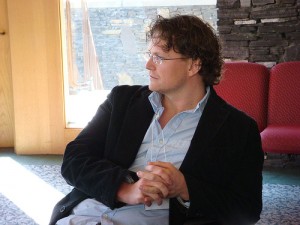
image © ken bautista
EDIT NOTE: This article was originally run in the Spring 2007 issue of Apatoons , a closed-loop a.p.a., and the longest running animation related publication in American history. With permission from all those involved, we’ve managed to get a Canadian Animation Resources exclusive!
*Be sure to read through to the end of this article, as we also have a follow-up interview as of this writing (Monday, July 5, 2010).*
The interviewer is yours truly, sir warren b leonhardt , and the interviewee is non other than Kris Pearn , an expat Canadian who has had quite a career, which has been recently capped off with the success of ‘Cloudy With A Chance of Meatballs’ , a project for which Kris acted as Head of Story – the bossman of the story team. This article contains a run-through from Kris’ early days all the way up to the early stages of ‘Cloudy’.
This interview is the full, unabridged version with updated links for more info. Just one of the many reasons why CAR.CA is a great place to get the goods on Canadians in animation.
Start of original article:
I had the good fortune to interview Canadian animation artist Kris Pearn, Head of Story on Sony Pictures Animation’s upcoming film ‘Cloudy With a Chance of Meatballs’. It was fantastic! We went on and on on the nature of the storyboarding job, the possibilites within it, we even waxed rhapsodic on the future of feature animation in the West. It was so exciting! Then I accidentally erased the entire hour and a half with one slip of the mouse. D’OH! He was such a good sport that he offered to redo it when I was in L.A. working on his show for a few months (I landed there through the directors. Kris was stuck with me! HA!). The redo never happened – beer and sushi got priority. Then, a few months ago in Banff at a workshop put on by the New Media Institute, we tried it again – same result. It was too much fun there!
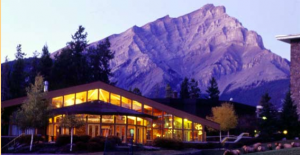 image © the Banff New Media Institute
image © the Banff New Media Institute
Called ‘Perfecting the Mix of Story: Interactivity & Screen’, it was the second such workshop to be held in two years. I went to the first one and had a great time, so I returned for this one. Good thing too, there were more people than at the last one and with more variety in their backgrounds (Mexican indie filmmakers, game developers, independant artists, a mechanic, even!). Ronnie Del Carmen, Head of Story from Pixar [*new edit – now with a studio in Vancouver!] was presenting an abridged version of the Screenwriter’s Expo show ‘Trust The Process’. Kris did his presentation on storyboarding and its travails; Josh Staub (from a games company called Cyanworlds – amazing guy and game/storydeveloper) presented his excellent film ‘The Mantis Parable’ and his process; and George Georgeadis, a newcomer to the games scene who’s making a real splash, did his on inspiration for his upcoming game ‘Dreamers’. Even though I’m not a gamer at all, these games looked quite interesting in terms of telling a story in a non-linear format. After that, there was breaking off into groups to get the feel of real story dynamics in play. And THEN, drinking, binge eating and dancing! Fun fun fun!
Long story short – missed the redo for the interview. But in between my four deadlines (DisneyTV board, WB board fix, a few textbook illos and this) and his crazy Head of Story schedule, we managed to meet up today via the tele-ma-phone and do it! So, without any further BS from me – let’s get to the straight poop:
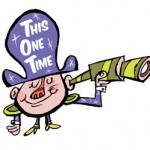
Warren Leonhardt {WL}: First of all, welcome to the first ‘This One Time..’ interview!
Kris Pearn {KP}: Well, thanks for having me!
WL: OK! Well, I was just wondering if you could quickly run over your work history. You started off as a designer at first right? And then you wound up jumping into boards on a TV show in Ottawa, is that right?
KP: Uh, yeah, but it’s a little more roundabout than that. I started out as kind of a jack-of-all-trades coming out of school [Sheridan College in Oakville, Ontario] just trying to catch whatever job you can. And then I ended up moving down to Phoenix, Arizona to work at Fox [Animation Studios], and I was an inbetweener there, and kinda moved through the animation stream, y’know, assistant animator on up to animator and then bumped over into pre-production because I wanted to get into doing boards.
So I was doing character layout and design, and then moved into doing boards for them.
And then that job ended, so I went back up to Canada, and I was doing design on another show, and then a friend of mine was directing a show in Ottawa, and that’s where I got my first TV board. So, after that I just kept working the boards!
WL: Ah well there you go. I’m an idjit. So you were at Don Bluth’s [Fox Animation] for how long?
KP: For about three years.
WL: For about three years…so what was it like working for that guy?
KP: Ah, he was a little crazy?
WL: (laugh)
KP: Um, but I mean the studio had it’s issues – it was back during the whole 2D boom [late 90s], and all the studios were in the same game, so it was very competitive at the time. And we were sort of an island out there in Phoenix because most of the industry was in Los Angeles. It was good in the fact that I was pretty green and I got to do a lot of cool things because it was a fairly small studio.
And one of Don’s philosophies is that he likes to train people, so it was good for that. But, the overall atmosphere of the studio was a little bit dysfunctional – I guess you could say they all are. Part of that was just the stress of trying to compete at that time in 2D.
WL: Trying to compete at that time and so isolated as well, made for what?
KP: Well, everybody was – when you’re the only game in town, it’s sort of fosters an isolated society, I guess. You know what I mean? There’s not as much cross-pollination going?
WL: Right.
KP: As opposed to here in L.A., you kind of feel like you could just stay here forever because this is where all the work is. I mean, even when things are bad, there’s all sorts of studios constantly doing something. Whereas out there in Phoenix there was…I’d say there was a sense of a…at the end there was a real sense of fear kinda motivating the studio, which is never a healthy thing, and it leads to other problems. But for a young artist it was fantastic because I got to do all sorts of things that I wouldn’t have been able to do if I was at say, Disney or DreamWorks.
WL: So did Bluth spend a lot of time one-on-one with you at all?
KP: Actually he did, closer to the end there. I ended up supervising the character layout department, so I was working just right outside of his office there. It was a small department of only like, three people, so I got to watch him draw a lot.
He was an incredible draftsman – I mean, sometimes his storytelling sensibilities are a little bit wonky, but he could sure draw like crazy. I just learned a lot from watching him design his drawings.
WL: Yeah, it’s always amazing watching someone who really knows how to draw just blast it out.
KP: I know – because I muddle and hack at it!
WL: You do!? It sure doesn’t look like it, tell ya that much.
KP: Well, I mean, I think it’s one of those things: the older you get – it’s like walking I guess, y’know – it gets easier.
TELEVISION V. FEATURES
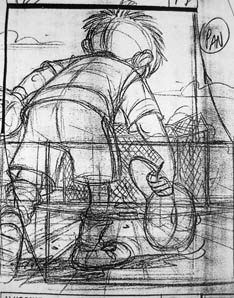
some of Kris’ work © Nelvana Ltd.
WL: I suppose, yeah. So, you’ve done quite a lot of TV boards before you actually wound up at Sony, is that right?
KP: Yeah. I was back up in Toronto for about three and a half years. Working primarily for Nelvana doing all sorts of shows – whatever came through there.
WL: You actually did some really nice work on some mediocre shows! I actually kept copies of a lot of that stuff when I saw it.
KP: Well, I don’t know how you feel, Warren, but I think whatever’s at your desk you just do the best you can, y’know?
WL: Well yeah. That’s the only way to do it, otherwise you just wind up treading water and that’s no fun at all.
KP: And you can’t give in to the bitterness of what it means to actually make a living in this business. Pointing to that knowledge that you’re drawing cartoons, so just shut the f@{f2e86ea6af82e2bb048871abf045622abf0ed27fb513932dc1ee8c05a54cbefd}k up and be happy, right?
WL: Yeah, that’s just it! That’s just it. I remember that you had told me once that now and then you actually miss doing TV boards. Why is that?
KP: I do. Well, the thing about TV boards is you get to complete a thought. You’re kind of responsible for – usually, I mean, you probably have the same experience – but usually you’re responsible for a good chunk of the show, if not the whole thing. I mean, if it’s a fifteen minute episode. And if it’s a twenty-two minute episode, you usually get half of that. So you have a good chunk of story to tell. You tend to get some continuity going, and you tend to be able to fall into the storytelling because you don’t have as much stopping and starting. And there’s a mentality where you just get it done.
And for me starting out doing boards, I thought it was a good experience because you kinda learn how to do your own cutting, because you have to. If your boards don’t cut, they don’t ask you to do any more.
Whereas in feature, there’s a danger of getting by without really knowing a lot of that, because it’s so catch-as-catch-can, and you always have three or four people working on a sequence, and it goes back and forth between editorial so much. And you’re working on one little part of the movie, and you’re not even necessarily completing that thought because there’s so many other factors that go into it. It’s just the nature of the beast.
In TV, you just get it done, and you learn by making mistakes and you just keep going, and you make more mistakes and keep going, and eventually you make enough mistakes you kinda look like you know what you’re doing.
(both laugh).
WL: I think that pretty much sums it up for just about everyone!
KP: Yeah! We can talk about the great thing about the feature process too. The difference there is it’s more about the creative intent, and you spend a lot of time talking about ideas and brainstorming ideas, so in a lot of ways you get more into the centre of the project.
But it’s not the actual sitting down and putting it together. I always found that rewarding with television boards because you can kinda relax, and in a way, kind of own it.
WL: I see what you’re saying. One thing I really enjoy about features too is being able to throw stuff out there and see if it sticks. The exploratory part.
KP: Yeah! You probably get that with some TV shows. I found you get that every now and then when you get on certain projects up there in Canada.
WL: Yeah, I’m finding actually more and more American networks and clients are expecting that. They’re expecting the board artist to bring something [gags, story points, suggestions].
KP: Are you guys actually pitching ideas and stuff?
WL: Oh yes. That’s what’s been happening on the last four shows I’ve been on.
KP: So you’re standing up there and –
WL: Yep. Go out there and pitch the roughs, with new ideas added to the script. I was working on the ‘Wayside’ show and I was pitching to Peter Gal [Nickelodeon’s development exec] and somebody who owned Teletoon and I don’t know who else. Same old thing! But it was good, though. It was great because we [board artists] were expected to make up good, usable stuff and jam with the director and whoever else was good in a room, so…
KP: That’s really good.
WL: Yeah, it’s kinda fun.You’ve been at Sony for how long?
KP: Four years now!
HEAD(ACHE) OF STORY

Kris’ work on ‘Open Season’ – image © Sony Pictures Animation
WL: You started there as a board artist on ‘Open Season’, is that right?
KP: Yes I did.
WL: Did you work your way up to Head of Story on that show, or was it the one after?
KP: Actually, on ‘Cloudy [With a Chance of Meatballs’], due out in 2009 – that’s the one I’m Head of Story on.
WL: How has your day-today changed from being a board artist on a feature to being Head of Story?
KP: There’s a lot more management in terms of the job I do now. I’m in a lot of meetings whenever story-related things are happening: like when we’re pitching a board or we’re launching a sequence, I’m usually there with the artist. That’s mostly to make sure there’s somebody on the floor who always has continuity. So as ideas are forming, as you bring your ideas to the table, if you’re the artist, you have somebody with you at the point of the launch or the point of the pitch [whom] then you can go back to, so the whole idea of riffing can continue.
That’s a big part of my job: just making sure that the creative wheel is still being lubricated, I guess….does that sound dirty?
WL: Yeah…and I like it. (laugh)
(Laughs)
KP: You know what I mean? It’s not always easy to get the directors, and the story process is not a nine-to-five thing. You know what I mean?
WL: Yeah, I do. Not only that, but it actually was very handy for me when I was working on that show [’Cloudy With a Chance of Meatballs’]. I know that you’re easier to reach than the directors anyway.
KP: And I think the nice thing about that is I try to never block ideas.
WL: You’re awesome at that, I gotta say. You just don’t block anything from anyone. It’s great!
KP: And that’s basically because it’s not conductive to the process. You never know where a good idea is gonna come from. You have to divorce yourself from ego, and just sort of deal with the facts on the ground, and let things play out – I guess help opinions find their home.
THE DAUNTING BLANK PAGE
WL: That’s the way to go! What’s your favourite method for breaking into a sequence or a script? Or do you have one?
KP: It all depends on the type of sequence. I approach an action sequence much different than an acting sequence. A lot of it depends on what the sequence needs, and I think in terms of breaking in, sometimes that’s the difficult part – trying to figure out where to start.
I know with a lot of action sequences, I’ll start by dealing with the overall choreography of the whole piece. For that I’ll go to other shows. If I’m doing a car chase, I’ll sit myself down and watch three or four car chase movies just to get the rhythm in my head. Just try to absorb the language of camera. And then go back in and try to figure out what I need to do for the characters in the sequence.
WL: Do you go back in and just go straight-ahead, or do you go through key set-ups first? Like you know you’ll gotta hit that point and that point?
KP: Usually I start at the beginning and I kinda muddle through and I always find that – I don’t know if you find this – I tend to sort of deal with the blank page in a very tentative way. It’s like I have to warm up to it.
It’s like dealing with the fear of failure and the fear of open possibilities. You have to start someplace.
I usually start a at the beginning, and I just start loosely thumbnailing out ideas and then I find there’s a certain point with every sequence where there’s a ‘click’ and you find a rhythm and then it just gets done. Because you get rolling on it.
WL: Sometimes with action sequences I’ll just do a moment here and a moment there, and just find a way to stitch ‘em up. And other times, just barrelling ahead is more fun because you have to figure out how to get your characters out of a situation – just as much as they do.
KP: I always find there’s certain points where you get blocked, and then I’ll just have to change the way I’m thinking about something.
Like if I’m dealing with an acting sequence, and then suddenly there’s a weird bit of action that’s necessary – like have a character hit a mark, say – or get to a transition. And then you just start playing with ‘what if I put my camera here? What if I put my camera there?’ Try to find how you’re gonna illustrate that physical need within the sequence.
Most of the time you gotta try to figure out what your characters want and what they’re after in a sequence.
WL: Yeah, what the whole point of the sequence is, right?
PERFORMANCE ANXIETY
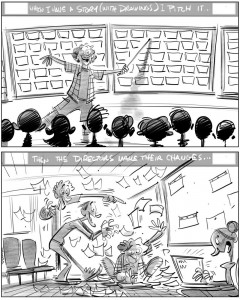
Kris at work – image © Kris Pearn
KP: Yeah. Because you know, we’re not on the hook to do what animators do in terms of fleshing out full performance, but we want to start paddling the canoe down the river. Towards good acting, and good thought processes in the characters.
WL: Just kind of opening it up for the animators to do that performance, you mean?
KP: Yeah, yeah. And I think it’s a difficulty in animation in general – if you’re an animator or a storyboard artist – because unlike live-action when you cast an actor for a role; I mean, the script is handed to the actor, and the actor assumes that character. They become that character for the duration of the TV show or movie, or whatever it is.
But with storyboarding and animation, you work on all the characters! And you’re the cameraman, and you’re the editor, and you’re dealing with all these different hats. So sometimes it’s not the easiest thing in the world to get into the skin of every actor, or every character in your story.
But that’s ambition: to try to understand [the character] as best as possible, or at least provide business or platforms that feel like they’re honest.
WL: So someone can work into it and pull out that kernel that needs to be in there.
KP: Yeah. I always find – I don’t know whether you find this, Warren – but whether you’re dealing with a comedy sequence, or a dramatic sequence, one of the hardest things is to try to find different voices for the characters. Because in the end they’re gonna be different actors, or different performers, so you’ve got to figure out how to separate yourself from them and still empathize with the characters.
WL: That’s always a tricky step, that’s for sure. That’s one thing that Ronnie Del Carmen was saying at the Banff Centre – about bringing your own personality into it to a point, and then realizing that they are different people – and trying to anticipate that; through observation of people you know, and how they would react to something.
KP: I mean, a lot of that is empathy, right? It’s trying to understand the point of view of a character, even if you don’t like the character. And getting outside of your own head is the only way you can really do that.
YOU’RE PITCHIN’, BUT WHO’S CATCHIN’?
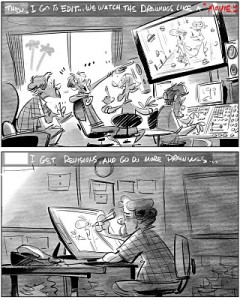 Kris at work – © Kris Pearn
Kris at work – © Kris Pearn
WL: Remember how Ronnie Del Carmen was talking at the Banff Centre a couple of months ago about how Pixar – they’ve almost done away with pitching altogether, haven’t they? I mean, he was talking about using an editing program to make a quick leica of a sequence, and then sending it down to the server? [and the Head of Story would review and give notes – before it would go to editing]. And then he was saying how some board artists miss that instantaneous feedback of a pitch.
What’s your take on the function of pitching and it’s role in feature pre-production?
KP: I think as an artist, in a very simple way, the pitching is something I would miss losing because in a lot of ways it’s you representing your work, and if you’re confident in the work, and if you’re confident in the pitch, it’s kind of your moment to stand up and let them see you and what you do, you know? Job security…I’d worry that without the pitch some execs would think the computer did all the work.
Because when it gets to film, you’re no longer really in the process – you’re kind of divorced from it.
The danger with the pitch is that if it’s a funny pitch because of the performance, that doesn’t always translate through. So I think the idea of an edited sequence is quite often more honest to what’s gonna be there once you pull it off the wall and put it into the Avid.
I do think that if you lose something as you translate from the board to the Avid, sometimes seeing it in a live show will reveal a potential for a sequence that may not be there in the drawings, but it can sit there in the director’s and the executives’ heads – and remain there as something to strive for in a sequence.
I don’t know, it’s hard to say. Sometimes things die on the wall and they survive in editorial; and things that thrive on the wall get to editorial because of the fact they thrive on the wall. I guess what I’m saying is that story is a bitch and there’s no easy answer for what works from one scene to the next. I’m not talking clear, am I? (laughs).
WL: Actually it makes sense. What I’ve always liked about the custom of the pitch is that is prepares the audience to watch something. They’re expecting a show, and ready for it, and here it goes! And I think it creates a more favourable environment that way.
KP: And I always find that no matter how brilliant you are as an artist or as a human being, the ideas will go [only] so far from your office.
And when you pitch it to a group of people, especially when I’m pitching to my peers, I’m always amazed at how things get batted around and how ideas grow from just putting them out there into the world.
WL: I think that’s the real strength of the pitch session right there: It’s what happens after.
KP: Yes. Yeah, and the conversations that come. Now, mind you, you get that in editorial too. We had that experience on this movie where – I think it was you, me and another artist were up there looking at editorial and that spun into an hour long conversation afterwards on the possibilities of a sequence.
WL: Oh, that’s right, yeah.
KP: If you took the pitch out of the equation – I’m not necessarily saying you won’t get those conversations, but I think having the pitch puts it in a live setting. I think there’s something spontaneous about it, and there’s an energy you get from that.
WL: I think when you go up to editorial and see the same thing afterwards, you have a better chance to knock it in line with the pitch if that was a little bit stronger [than what was on the screen]. But like you said, you can have a more objective look at it and still bounce things around. I remember that session. That was you me and…Jason Lethcoe, wasn’t it?
KP: Yeah. That was Jason.
WL: That was great. That was a lot of fun, that one. So what’s your favourite part of the gig that you got right now, anyway?
KP: Well, I love pitching. I love the drawing. I mean, anytime I can just sit in my office and draw, that’s a good day.
WL: It’s kind of a treat now, is it?
KP: Yeah, it comes and goes…you know, with all the meetings and stuff. I love collaborating too. You’ll have painful sessions where it’s hard because you’re kind of chewing on a piece of metal, you know what I mean? That’s what it feels like sometimes with story. And then all of a sudden it’ll just crack and it’ll flow, and it’s like the room will get hot. And I love that experience. You know what I mean?
WL: As soon as everyone gets going on the same track and it looks like it’s going somewhere, that’s the best part. Usually it takes a good twenty minutes of spinning your wheels, and turning it over and looking at it…
KP: There’s not much in this process that’s easy. That’s something that Ronnie [Del Carmen] talked about too. It’s reassuring to know that they suffer up at Pixar too.
WL: I think was refreshing to a lot of people when you put on your session in Banff as well, because you made it pretty clear that kinda hurts all over.
KP: It’s like parenthood I think, isn’t it? [Kris is a dad].
WL: (laughs) Yeah, I guess so. [Warren’s a dad].
KP: You can look at it like they’re little angels, but the truth is, they’re gonna shit everywhere, and they’re gonna make horrible decisions and you’re gonna have to be fighting for the next twenty years to hopefully keep them alive…
WL: And yet, you only show other people the portraits where they’re smiling and perfect…
KP: And when it’s all said and done, you look back and you forget all the bad stuff. I think there’s a lot of that that happens with the story process. (laughs). Y’know I think it’s painful because it has to be…
WL: Are you one of those ‘Art is Pain’ types, or what?
KP: I think life is pain, y’know…
(Both laugh)
WL: The journey is suffering, and that’s the whole point, eh?
KP: I think that any job that is mentally stimulating for one person is gonna be mentally stimulating for all ten people who are involved in the same job and everyone’s stimulated in a different way – which means there’s gonna be conflict. And that’s part of the process, y’know?
I love getting into passionate conversations about story because even though it may be heated, there’s always that energy that you get at the end where it feels like you got something out of it.
WL: What I always like is getting into conversations like that with people who can get their egos out of the way.
KP: That’s an important thing to do, and it’s not always easy to find that. I think for the most part, with my experiences here at Sony, they try to create that as much as possible – in terms of the choices they make and who they bring into these rooms and stuff. But it’s a hard process, because, you know, a lot of it’s chemistry. Being able to trust the people around you. The hardest thing in the world is to throw up a bad idea.
WL: Is it ever, because most likely you’ll catch it right back in the face.
KP: Yeah! But a room that punishes people for a bad idea is a room that will never find a good idea.
WL: That’s a good point.
KP: And that was something that Ronnie talked about a lot in Banff as well, was sitting there in a story room where you’re just batting things back and forth, and once you get the egos out of the way you’re not worried about people’s feelings, just worried about trying to get to the good idea. There’s a lot of trust in that.
WL: That seems the main thing: finding the right crew to trust, and then just going for it…
KP: Yep. You get less of that in television, I think…
WL: Television’s kind of a weird animal that way. A few of the times I’ve been pitching, there’s been good rooms and bad rooms. For the most part, I’ve been pretty lucky, I think, when it comes to the TV pitch.
KP: Yeah. But you come in with your personality and stuff, and that’s part of it too.
WL: Well yeah, I’m so damn charming.
(both laugh)
BANFF CENTRE
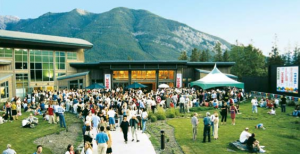
image © BNMI
WL: So what was your overall impression of the Banff series so far? You’ve presented twice already…
KP: Yeah! I always find that the conversations that come afterward are often as rewarding as the whole structured program. It’s just nice to be around creative people and talk about ideas. I think it’s good! I think it’s good to get the community together as much as possible.
WL: There doesn’t seem to be a lot of community animation-wise out there, which I found kind of refreshing in a way. Because everyone has such different points of view and different ways of working…but at the same time, I’d like to see it grow into something a little bit bigger. More conducive to getting a bunch of people in a room and launching projects.
KP: I find that you get little pockets of here and there. Even in your life, you look at pockets of times where you had that collaborative environment. Whether it was back at school, or certain jobs where everything clicks and you’re in sych with your crew. Quite often, you end up on the other side and you’re kind of alienated and you’re working on your own. In your own little hole (laugh).
The thing about the Banff Center is that it’s a nice social gathering that’s also focussed on being creative, and I think that exercise is really valuable.
WL: And it’s in a beautiful spot too.
KP: It’s a nice place! Nice part of the world.
SURF’S UP!

image © Sony Pictures Animation
WL: So I see you were also credited with story work on ‘Surf’s Up!’ which I just saw last Tuesday.
KP: What’d you think?
WL: I thought it was pretty alright, y’know?
KP: I was amazed. They pulled a lot of stuff together in the last little while. Because of the mockumentary style, I think it was a hard movie to find a rhythm.
WL: Yeah, I kinda felt it bumped a few times in the transitions from a mockumentary style into more of a straight dramatic camera use. But I think overall it held together that way.
KP: it was sure a pretty movie, though, wasn’t it?
WL: It was gorgeous! And the animation was so shit-hot.
KP: Yeah, I know. And the thing about 3D is you can do so much with it now. Pixar led it, and a lot of these movies now are making more style choices, which I think is wonderful.
WL: One thing that I really liked about ‘Surf’s Up!’ – and my wife liked, and a lot of the kids behind us liked – was that the characters weren’t constantly yelling at you all of the time. In fact they were telling each other to calm down, chill out.
KP: Well, part of that’s the surfing mentality. Yeah, they hired a few limos and took the executives down to the beach to go surfing. (both laugh) I think maybe that translated through the process…(both laugh)
WL: Not only that, but I think the overall message seemed to be just takin’ it easy, and letting life come as it does, and so many animated films are so goal orientated that way. So I thought it was pretty refreshing in a sense.
KP: That was also part of the problem with the movie for me, because they wanted to keep a tone that was fairly on-message with the whole surfing culture, but…ah…Kids don’t smoke a lot of pot, y’know? You had to get some conflict going in the movie.
WL: I could see how that would be a major bone of contention because otherwise you won’t have anything happening.
KP: Yeah. I felt at times that we should just do ‘The Karate Kid’ with penguins, because it was a sports movie…and for a while there, it was more like we were just watching a bunch of water. (laugh). I could do that for free if I just walk over a hill. But I was wrong…I’m wrong a lot. The movie worked out well.
(both laugh)
WL: So how was your experience with the crew on that?
KP: You know, I enjoyed my time on that project. It was a different culture than ‘Open Season’, it was not nearly the same sort of room – in terms of how the sequences were launched and how the reviews were done.‘Open Season’ was a fairly boisterous experience where there was a lot of laughing…it was a comedy, and y’know, there were certain personalities on the crew that always made it feel like you were walking into a roast.
WL: Right on! Who was that?
KP: Oh, Dave Feiss and a guy named Matt Taylor who did a lot of the voices. You remember Matt, don’t you?
WL: Yeah, oh yeah.
KP: Dave Feiss was the Head of Story on ‘Open Season’ and he was the creator of ‘Cow & Chicken’…his personality is very gregarious, very silly. He likes a lot of the silly stuff, so…The tone of ‘Surf’s Up!’ was a little more mellow. I guess it was a little more like a surfing movie (laughs) and I always enjoyed drawing the characters, and I enjoyed the back-and-forth with the directors. Tonally it was a different movie, so…
WL: So the crew was reacting tonally differently as well, eh?
KP: On ‘Open Season’ we had a bit of a rag-tag bunch of misfits and has-beens kind of pulled together (laughs) kind of ‘the Bad News Bears’, right? Because, the way the studio was set up, they were trying to garner talent from the industry…we had certain executives that came over from DreamWorks but before they could hire the people they knew, they had to wait for contracts to come up.
So, they were taking risks and hiring unknown artists to get their first production off the ground. That’s how I got in. If I were to apply now, I probably wouldn’t have had the opportunity because I was just a TV animator from Canada. Or TV board artist from Canada. The hassle of immigration, relocation, and then seasoning of a green artist…well, it’s a big leap of faith on their part. I’m grateful for my good fortune. So there was a different energy because we were all kinda too stupid to know we couldn’t do the job. (laughs). You know what I mean?
And by the time ‘Surf’s Up!’ got rolling, the studio had grown and they had hired a more experienced crew, because they had a lot of very seasoned Disney guys, and DreamWorks guys, and many of them came down from the Valley, so they’d work from home, like, two or three days a week. L.A. is a city where geography kind of dictates your life, so…one of the ways they were able to attract talent all the way out on the westside to Sony was to give people flux time.
So the whole energy of the project was a little bit more like a TV show, where you weren’t so much in the room. Which was fine. And actually the project thrived in that environment because it was very disjointed anyways, because everyone was working on their own bits of the mockumentary.
My biggest challenge on ‘Surf’s Up!’ was trying to figure out how to manage the camera – from the practical point of being a board artist – because in this movie the camera is essentially a character in every scene you’re doing. It has a point of view because it’s a documentary. So I found that to be really exciting and challenging, and fun.
OPEN SEASON

image © Sony Pictures Animation
KP: Yes.
WL: …and did it feel…familiar? Did it feel…alien? Did it kinda blow your doors off at first?
KP: It was terrifying at first. It was terrifying being in the room. I’m naturally a very shy person…
WL: You are not.
KP: I am. (both laugh) A farmboy growing up in the middle of nowhere in Ontario didn’t really have any neighbours, so…I just…talked to myself a lot (both laugh).
WL: You hide it pretty damn well.
KP: Well, it’s been many years of doing this job. I found walking into the experience was scary, but once you kinda got to know everybody…
The other thing is, when I came into the project, they had coalesced a crew that was generally pretty damn cool. Everybody was very relaxed. Like we were talking about earlier, about the ego being out of the room, I never got the sense that anybody was vying for anything other than just the best idea for the movie.
One of the things that I really took away from that experience, whether the movie was a success or a failure, the wonderful thing about working on that project was: there was never a rejected idea when we were talking. At some point, of course, the directors [Roger Allers. Tony Staachi & Jill Coulton] had to say ‘yes’ or ‘no’ and eventually you have to shave it down. But we were allowed to be free in terms of how we expressed ourselves, and how we found the character voices and stuff.
WL: Very nice! I see you even got some of your stuff into the ‘Art of [Open Season’ book]!
KP: Yeah! Actually even ‘The Art of Open Season’ and ‘The Art of Surf’s Up!’ book too! The irony is that when I was here for the very first two months, I did a handful of drawings – designs of penguins. And then I did these beat boards for ‘Open Season’ and those are the only two things I’ve ever gotten into these ‘Art of’ books, so… I could have left after two months and – (laughs)…
WL: Still be famous and worth a lot of money? (joking)
KP: Yeah, right. (laughs) You don’t get anything for those things…
WL: You got an Annie nomination [in 2006] for ‘Open Season’ as well, though, didn’t you?
KP: I did! Yup.
WL: And you went to the awards? How was that?
KP: It was a big show! In a low rent sort of way…Actually, it was the same night as the Grammys so…ever been to the Rotary Club?
WL: Yeah.
KP: It was a bit like that. (both laugh) But, y’know, in animation, we have a different image than the rest of Hollywood. No glitz, but some decent Chicken Kiev in a parking lot tent…fake grass and everything! Tom Kenny [voice of Spongebob Squarepants] did the MC-ing for the ceremony and he was great.
BACK TO THE FUTURE

End result? A film made by a LOT of people
– images © Kris Pearn & Sony
WL: How’s things looking for Sony? I’ve heard the next release is a bit of a ways off. So you’ve got to be riding on ‘Surf’s Up!’ for a while?
KP: And that’s a tough one. The reality is we’re sort of in a 3D boom, like we were in a 2D boom or glut back in the mid 90s. And so we’re looking at a whole bunch of studios trying to get into the same market. So far Sony’s had a rough go in terms of release dates [etc.]. The production quality of our movies is definitely up there. I think [Sony] Imageworks [who do the animation production *new edit – now with a studio in Vancouver!] should be able to last a few rounds in the ring with Pixar…dangerous ring, though.
And I would actually put money on our story crew and the talent here and the creative impulse behind this place. We absolutely have some of the most gifted artists in animation working for us. A great mix of personalities and abilities – like yourself! This studio has potential to be an amazing place, because it doesn’t have a brand name that it’s a slave to. Yet. On the other hand, we’ve got to crack into that market to find a way to land a really successful film.
So that’s sort of the rub that we’re in, in terms of riding out to [the next release]. I’m very hopeful for [’Cloudy With a Chance of Meatballs’] because it’s so weird, and it has a tone that is completely unique in terms of anything I’ve seen in feature animation. Speaking from my point of view, I came down here because it was a new company, and it promised something I think it could still deliver on if they have the courage to do it: make something that’s not necessarily branded specifically for one target audience.
I think if any studio can take a chance and make animation for an older audience, kick ass storytelling using the medium to heighten action and create intense, dynamic stories…this is the place.‘Monster House’ is a good example of a movie that is just really satisfying without feeling like the standard feature animation re-hash.
I think this is something that Pixar has allowed itself to do – look at ‘The Incredibles’ – they’re able to relax, and make movies for the sake of the movie. Never alienating that audience, but they’re not pandering to that audience, either.
WL: They do seem to have the courage to go where the story needs to go.
KP: And I’m sure it’s a hard-fought courage. I guarantee you that there are things that they did in ‘The Incredibles’ that probably made the execs at Disney go crazy in terms of storytelling.
WL: Undoubtedly. How often are animated protagonists actually in real mortal danger these days? And I have a feeling ‘Ratatouille’ has some of those qualities as well [in terms of bolder storytelling].
KP: I’m really looking forward to seeing that movie. [Movies like] ‘Shrek’ and others, as wonderful as they’ve been for the industry, I fear they may have done a lot of damage to it as well. Everyone’s doing the wise-cracking, self-aware character movies now. To me that’s worse than the fuzzy-animal trend. But it’s not making as much money as it used to, with the exception of ‘Shrek 3’.
Hopefully [that phase] will be gone soon and [the industry] will be back to telling stories for the sake of story.
WL: Well, I guess we’ll see how it’ll all come out in the wash. I guess we’ll cap it there because that feels like a good spot to end it. Thank you so much for your time.
KP: OK! Thank you.
WL: That was Kris Pearn, 2006 Annie Award nominee for Storyboarding in Animated Feature Production, and currently Head of Story at Sony Pictures Animation in Los Angeles [*new edit – well, circa 2007, anyway]
The Follow Up Interview – 3 years later:
WL: So Kris, welcome back!
KP: Thanks! Heheh.
WL: The last time we talked to you was 2007.
KP: Long time!
WL: Yeah! So ‘Cloudy’ has come out, obviously. So, what’s your reaction?
KP: Changed my life, Warren. I’m a wealthy man now.
(LAUGH)
KP: Naw, I think it did okay! It wasn’t a blockbuster but it was our biggest hit that we had at Sony, and I think the most important thing was that people seemed to like it. People who didn’t necessarily respond to the marketing responded to the film when they saw it. I had a lot of people say that they kinda held off for a while and when they saw they liked it and were pleasantly surprised. So it was good that it surprised people.
Even though it went through the meat grinder of the studio, it came out still feeling like an original film that came from Chris [Miller] & Phil [Lord]. It had their voice – that was great. It was a really positive experience.
WL: That’s the thing that impressed me the most. I know what kind of notes you guys were looking at in 2006 when I was on the show, and to see what came out the other end was great because the notes got totally filtered through the story crew and the directors/writers. You answered the notes without ‘sounding’ like every other studio.
KP: Yeah – and it wasn’t an easy fight. I know Chris & Phil fought for that film right till the bitter end. The strange thing about being in the story department is when the film comes out, you’ve been off of it for six, seven or eight months. So in some ways it kinda numbs you a bit to the actual event of the film coming out – you’ve sort of moved on, you’ve got a new girlfriend now and all that kinda stuff?
I was really afraid of it when I went to the theatre to see it, actually. I was really frightened about what I was going to watch because I’d heard all of the stories about stuff that got compromised in the last few months. It turned out that it didn’t necessarily damage the film. And in fact, if I didn’t know what was cut, I don’t think I’d miss it so I think they made good choices for the continuity and the pacing of the film. So all in all, I think it worked out nicely. They weren’t wrong about the things that had to be compromised near the end.
WL: Well, it’s already been announced, ‘Arthur Christmas’ is coming, and Sony’s involvement with Aardman Animations over in Bristol, so after ‘Cloudy’ were you bounced straight to Bristol?
KP: Pretty much! It was one of those things where the opportunity started showing itself probably about six months before I was to finish on ‘Cloudy’ so the timeline didn’t look like it was ever going to meet up. Luckily one film accelerated, the other film stalled, so when ‘Cloudy’ ended I was able to roll straight into ‘Arthur’ when it was still sort of ‘blue sky’ project. We didn’t have a lot of material then, so they needed a full-on story crew working on it. It was a good opportunity to get in on the film in that stage of the process.
I got to work with a longtime friend, Donnie Long, he was Head of Story at the time on that project. He was also Head of Story on ‘Open Season’. Me and Donnie went over to Bristol and we formed a team of story artists over there. The interesting thing about Aardman is it’s a renowned company – they’ve been around for a long time and made quite a few films – but they don’t have a huge infrastructure in terms of feature animation production. They tend to grow and contract depending on their needs, and they haven’t made a movie since ‘Curse of the Were-Rabbit’. At least, not a feature film, I should say. So a lot of our story people were brand new.
Aardman does have an investment in their talent in that they had a story training course. So we grabbed a handful of people from the story training course and we brought a couple people from some other places, but it was a really green crew which made it a lot of fun to learn together. Which is nice, sometimes you get a lot of attitudes and egos, but it wasn’t at all that way over there. And there was no ‘America Vs. Britain’ dynamic happening there at all, which was something I was kind of concerned about going over there. It was just really a lot of fun.
Yeah – they actually have two movies going there now, the other was announced too, called ‘The Pirates’ – based on a series of kids books. That’s a Pete Lord film, and they’re kind of being done at the same time, but that one’s in stop-motion. The reason why ‘Arthur Christmas’ was collaborated with Sony was because Aardman doesn’t really have a huge infrastructure. So the idea of doing a CG film over there – the infrastructure just wasn’t in place, so we’re gonna animate it here in Culver City (or Vancouver). Whereas the ‘Pirates’ are gonna be done entirely in Bristol.
WL: With a younger crew like you had, there’s nothing but raw energy and that’s infectious, which can work really well.
KP: And I think with Donnie and myself there we kind of brought the bitterness, so we were good.
(laughs)
KP: It was fun, because with a green crew I was training a couple of artists and it was a bit of a different dynamic from ‘Cloudy’ in that here, Donnie did a lot of the heavy lifting in terms of the politics and studio stuff. We sort of shared the operation of the crew. Put all the *hard* work on Donnie’s shoulders (laughs).
WL: What was it like working with director Sarah Smith? I’m afraid I’m not too familiar with her work.
KP: She comes out of the BBC, the series where I became aware of her work was called ‘League of Gentlemen’. It was about this small village in northern England where it was populated by these locals that a little weird and kinda inbred, and at the end of every episode a stranger would wander into town and not leave. Sort of a ‘Hotel California’ kind of thing. It was always kind of a morbid demise for the passerby. A dark comedy about the kind of weirdness of Britain, I guess.
She tends to write kind of ‘dark’, which I like and her sense of humour is very unique. ‘Arthur’ is a very different-feeling film.
WL: So ‘Arthur Christmas’ comes from her, did she write it as well?
KP: Yeah – it’s very similar to the what I call the ‘Chris & Phil’ approach – she’s very much the conceptual parent of the film and she is taking it through all the phases of pregnancy right now. That came out wrong.(laughs)
WL: I’ve got to say that’s great that Sony seems to be trending towards that kind of template, other than of course ‘The Smurfs’ which seems to come from another place entirely.
KP: Well, I wouldn’t necessarily say that’s the studio model, it might be a luck thing having these two opportunities, but we’ll see. I hope it’s more of a trend with this studio. Let’s face it, it’s a business and they’re always trying to temper their risk in the products that they make. Quite often the author/director is not the easiest person to find in the creative community. I can promise you that we’re going to make movies that have ‘attached writers’ – long lists of attached writers – long lists of attached directors – it was just a matter of being on the right project, as far as my role is concerned.
I think it can happen at almost any studio. You must have seen ‘How to Train your Dragon‘ and even though it was a film that was picked up by Chris Sanders and Dean DeBlois, you get the sense that they authored it once they got their hands on it.
WL: Yes, that was a pretty impressive effort, in what was it, eighteen months or something?
KP: Yeah. So I think you can find that kind of blissful arrangement in any studio, it’s just a matter of getting on the right project.
WL: So you went off to Bristol under the auspices of Sony Pictures Animation the entire time, basically?
KP: Pretty much – Sarah was adamant on keeping the feel of ‘Arthur’ kind of Britishy – dunno if that’s actually a word – she wanted to have the idea of ‘place’ imbued in the storytelling. So it was really good for us to live over there and to have that experience to try to do most of the pre-production over there. I imagine there was also some sort of business structure to it, too – tax breaks and whatever. Creatively, though, it was a necessary thing to be over there and see how people speak, how the place feels and sounds. It’s one thing to look in a book, another thing to wander around on a Sunday with your dog, and see the way the countryside looks and try to find ideas out of those experiences and put them in the story.
WL: That’s the ideal way of going about it, really. That sounds promising! I’m looking forward to ‘Arthur Christmas’ and it sounds like a very original take on the idea and everybody could always use another Christmas tale to throw in the pile! Especially if it’s got it’s own ‘voice’ to it.
KP: (laughs) Yeah the holiday movies are always a jackpot, right?
WL: So when it is due to drop? Next year?
KP: Around Christmas, 2011. Although you never know with Sony’s marketing, maybe it’ll come out in June.
(Laughs)
WL: So you’re too busy with ‘Arthur Christmas’ I guess you’ve nothing to do on ‘The Smurfs’, is that right?
KP: Neeeeeeveeeeer touched ‘The Smurfs’. The studio is excited about it, I think it’ll probably be a box office winner for them.
WL: Well, that’s the main thing – whatever it takes to keep the lights on, eh?
KP: Well, yeah, we definitely need cash flow. Every studio does. (in a New York accent) It’s not an art, Warren, it’s a business! (laughs)
WL: (laughs) That’s the main thing to remember.
So there you have it. Former Sheridan instructor, television board artist/designer, and Head of Story and current senior story artist Kris Pearn. Follow his blog ‘Woeful Tales of a Domesticated Man’ and keep current.
Stay tuned for more profiles coming your way this summer (I have more than a few on deck) at CAR.CA! If you know of someone whom YOU’D like to see profiled on CAR.CA:Profiles, contact me via this blog or at my site’s contact page . The more requests we get, the more vibrant our community becomes!



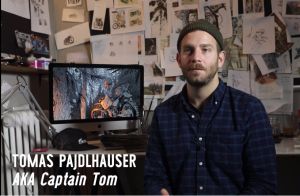
An absolute amazing read! Thank you!
[…] Hey guys, just posted a new interview with Kris Pearn, Head of Story on ‘Cloudy With A Chance of Meatballs’, over at Canadian Animation Resources. Check it out HERE. […]